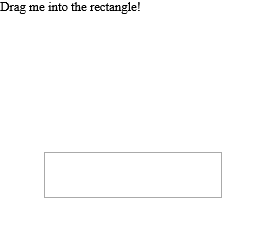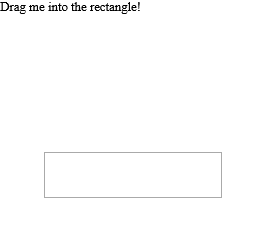
|
|
The |
Example of HTML ondragover Event Attribute
It will Execute a JavaScript when an element is being dragged over a drop target.
index.html
Example:
HTML
<div ondragover="myFunction(event)"></div>
Output should be:

Definition and Usage of HTML ondragover Event Attribute
The ondragover attribute fires when a draggable element or text selection is being dragged over a valid drop target.
By default, data/elements cannot be dropped in other elements. To allow a drop, we must prevent the default handling of the element. This is done by calling the event.preventDefault() method for the ondragover attribute.
Drag and drop is a very common feature in HTML5. It is when you "grab" an object and drag it to a different location. For more information, see our HTML Tutorial on HTML5 Drag and Drop .
Note: To make an element draggable, use the global HTML5 draggable attribute.
Tip: Links and images are draggable by default, and do not need the draggable attribute.
There are many event attributes that are used, and can occur, in the different stages of a drag and drop operation:
-
Events fired on the draggable target
(the source element)
:
- ondragstart - fires when the user starts to drag an element
- ondrag - fires when an element is being dragged
- ondragend - fires when the user has finished dragging the element
-
Events fired on the drop target:
- ondragenter - fires when the dragged element enters the drop target
- ondragover - fires when the dragged element is over the drop target
- ondragleave - fires when the dragged element leaves the drop target
- ondrop - fires when the dragged element is dropped on the drop target
Note: While dragging an element, the ondragover event fires every 350 milliseconds.
Browser Support of HTML ondragover Event Attribute
The numbers in the table specify the first browser version that fully supports the event attribute.

Syntax of HTML ondragover Event Attribute
<
element
ondragover="
script
">
Attribute Values of HTML ondragover Event Attribute
| Value | Description |
|---|---|
| script | The script to be run on ondragover |
Technical Details of HTML ondragover Event Attribute
| Supported HTML tags: | ALL HTML elements |
|---|
How to Execute a JavaScript when an element is being dragged over a drop target
It will Drag me into the rectangle.
index.html
Example:
HTML
<!DOCTYPE HTML>
<html>
<head>
<style>
#droptarget { float: left; width: 200px; height: 35px; margin: 55px; margin-top: 155px; padding: 10px; border: 1px solid #aaaaaa;
}
</style>
</head>
<body>
<p ondragstart="dragStart(event)" draggable="true" id="dragtarget">Drag me into the rectangle!</p>
<div id="droptarget" ondrop="drop(event)" ondragover="allowDrop(event)">
</div>
<p style="clear:both;" id="demo"></p>
<script>
function dragStart(event) { event.dataTransfer.setData("Text", event.target.id);
}
function allowDrop(event) { event.preventDefault(); document.getElementById("demo").innerHTML = "The p element is OVER the droptarget."; event.target.style.border = "4px dotted green";
}
function drop(event) { event.preventDefault(); let data = event.dataTransfer.getData("Text"); event.target.appendChild(document.getElementById(data)); document.getElementById("demo").innerHTML = "The p element was dropped.";
}
</script>
</body>
</html>
Output should be:

| html event attributes |
| List of Drag Events Attribute | HTML Drag Events Attribute |
| HTML ondrag Event Attribute | HTML Drag Events Attribute |
| HTML ondragend Event Attribute | HTML Drag Events Attribute |
| HTML ondragend Event Attribute | HTML Drag Events Attribute |
| HTML ondragleave Event Attribute | HTML Drag Events Attribute |
| HTML ondragover Event Attribute | HTML Drag Events Attribute |
| HTML ondragstart Event Attribute | HTML Drag Events Attribute |
| HTML ondrop Event Attribute | HTML Drag Events Attribute |
| HTML onscroll Event Attribute | HTML Drag Events Attribute |
| Example of HTML ondragover Event Attribute | HTML Drag Events Attribute |
| Definition and Usage of HTML ondragover Event Attribute | HTML Drag Events Attribute |
| Browser Support of HTML ondragover Event Attribute | HTML Drag Events Attribute |
| Syntax of HTML ondragover Event Attribute | HTML Drag Events Attribute |
| Attribute Values of HTML ondragover Event Attribute | HTML Drag Events Attribute |
| Technical Details of HTML ondragover Event Attribute | HTML Drag Events Attribute |
| How to Execute a JavaScript when an element is being dragged over a drop target | HTML Drag Events Attribute |
|
Type
: |
Develop |
|
Category
: |
Web Tutorial |
|
Sub Category
: |
HTML Drag Events Attribute |
|
Uploaded by
: |
Admin |
Read Article https://horje.com/learn/1434/reference